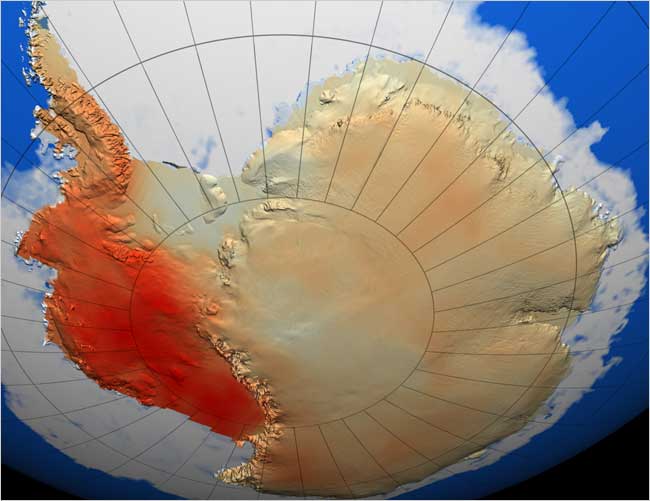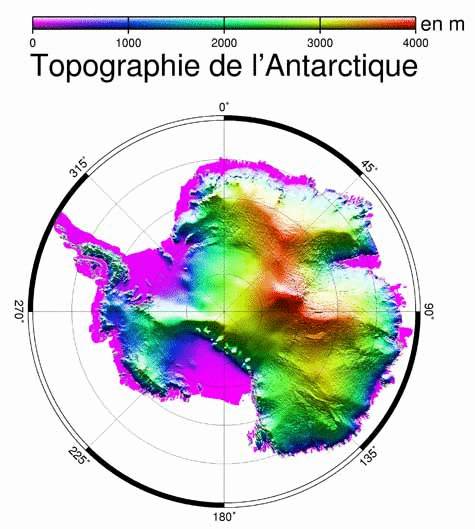Study Finds New Evidence of Warming in Antarctica

An illustration that depicts the warming that scientists have determined
has occurred in West Antarctica during the last 50 years. The dark red
shows the area that has warmed the most.
Antarctica
is warming.
That is the conclusion of scientists analyzing
half a century of temperatures on the continent, and the findings may help
resolve a
climate enigma at the bottom of the planet.
Some regions of Antarctica, particularly the
peninsula that stretches toward South America, have warmed rapidly in recent
years, contributing to the disintegration
of ice shelves and accelerating
the sliding of glaciers. But weather stations in other locations, including
the one at the South Pole, have recorded a cooling trend. That ran counter
to the forecasts of computer climate models, and global
warming skeptics have pointed to Antarctica in questioning the reliability
of the models.
In the new study, scientists took into account
satellite measurements to interpolate temperatures in the vast areas between
the sparse weather stations.
"We now see warming is taking place on
all seven of the earth's continents in accord with what models predict
as a response to greenhouse gases," said Eric J. Steig, a professor
of earth and space sciences at the University
of Washington in Seattle, who is the lead author of a paper to be published
Thursday in the journal Nature.
Because the climate record is still short,
more work needs to be done to determine how much of the warming results
from natural climate swings and how much from the warming effects of carbon
dioxide released by the burning of fossil fuels, Dr. Steig said.
But Drew T. Shindell of the NASA
Goddard Institute for Space Studies in New York, who is another author
of the paper, said, "It's extremely difficult to think of any physical
way that you could have increasing greenhouse gases not lead to warming
at the Antarctic continent."
Dr. Steig and Dr. Shindell presented the findings
at a news conference on Wednesday. They found that from 1957 through 2006,
temperatures across Antarctica rose an average of 0.2 degrees Fahrenheit
per decade, comparable to the warming that has been measured globally.
In West Antarctica, where the base
of some large ice sheets lies below sea level, the warming was even more
pronounced, at 0.3 degrees Fahrenheit, though temperatures in this area
are still well below freezing and the warming will not have an immediate
effect on sea level.
In East Antarctica, where temperatures
had been thought to be falling, the researchers found a slight warming
over the 50-year period. With the uncertainties, East Antarctica may have
indeed been cooling, but the rise in temperatures in the west more than
offset the cooling. The average temperature for Antarctica is about minus
58 degrees.
"There is very convincing evidence in this
work of warming over West Antarctica," said Andrew Monaghan, a scientist
at the National
Center for Atmospheric Research in Boulder, Colo., who was not involved
with the research.
As with earlier studies, the scientists found
that more recently, since the late 1970s, temperatures had actually cooled
in East Antarctica, a
phenomenon that many atmospheric scientists attribute to emissions of chlorofluorocarbons,
a family of chemicals used as coolants that destroyed high-altitude ozone.
Because those chemicals have since been phased out, the ozone hole is expected
to heal, and the cooling trend may reverse. |
The region of East Antarctica, which includes
the South Pole, is at a much higher elevation and extends farther north
than West Antarctica. While the scientists said the ozone hole most likely
had a significant influence on Antarctic temperatures, other factors, including
sea ice and greenhouse gases, may play a larger role.
"Obviously the situation is complex, resulting
from a combination of man-made factors and natural variability," said
Michael Oppenheimer, a professor of geosciences at Princeton, who was not
involved in the research. "But the idea of a long-term cooling is pretty
clearly debunked."
Dr. Monaghan, who had not detected the rapid
warming of West Antarctica in an earlier study, said the new study had
"spurred me to take another look at ours — I've since gone back and
included additional records."
That reanalysis, which used somewhat different
techniques and assumptions, has not yet been published, but he presented
his revised findings last month at a meeting of the American Geophysical
Union.
"The results I get are very similar to
his," Dr. Monaghan said.
OUI, l'Antarctique se réchauffe
http://www.futura-sciences.com/
Il n'y a pas d'exception antarctique... L'ensemble
du continent blanc se réchauffe bel et bien à l'instar du
reste du globe, et non sa seule partie occidentale contrairement à
ce que certains chercheurs pensaient.
«On entend régulièrement
répéter que l'Antarctique se refroidit, or ce n'est pas le
cas», insiste Eric Steig, directeur du département Quaternaire
à l'université de Washington à Seattle, co-auteur
avec Drew Shindell, de l'Institut des Sciences spatiales de l'université
Columbia, d'une étude publiée dans Nature.
Au moment où la banquise Wilkins semble
devoir se disloquer prochainement, ces chercheurs viennent verser une nouvelle
pièce au dossier, regroupant des données fournies par les
satellites ou recueillies sur le terrain depuis 1957. «Le réchauffement
de la péninsule et de l'Antarctique occidental est lié aux
changements de la circulation atmosphérique et à la diminution
de la banquise dans le secteur Pacifique de l'océan austral»,
ont expliqué les chercheurs à l'occasion d'une conférence
de presse par téléphone.
Un demi-degré en un demi-siècle
«Une des raisons principales pour
lesquelles on pensait que la plus grande partie de l'Antarctique Est refroidissait,
c'est la présence du trou dans la couche d'ozone protectrice qui
apparaît à partir du printemps dans la région polaire
de l'hémisphère sud. Ce phénomène est responsable
de la baisse des températures dans la partie orientale. Or, la situation
dans cette zone Est a été extrapolée à la totalité
du continent sans que rien ne vienne corroborer cette idée, souligne
Eric Steig. Et si le trou dans la couche d'ozone disparaît au milieu
de ce siècle, comme il est envisagé par les scientifiques,
l'Antarctique dans son ensemble pourrait se réchauffer comme le
reste du monde».
Selon les multiples relevés pris en
compte par les deux chercheurs, la température moyenne de l'ensemble
de l'Antarctique a augmenté de 0,5°C depuis les années
1950, un ordre de grandeur très compatible avec l'ensemble du réchauffement
climatique global.
Les scientifiques concluent leur rapport dans
Nature en affirmant que la hausse des températures dans l'Antarctique
est difficile à expliquer sans faire intervenir l'augmentation des
émissions gaz à effet de serre due aux activités de
l'homme.

Topographie de l'Antarctique. Crédit: Institut polaire français
|

